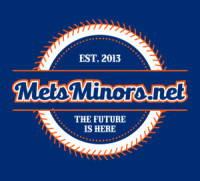
Photo: Ed Delany, MMO
At almost every level of the Mets minor league system, there is one standout defensive catcher. Just like we see with Tomas Nido at the Major League level, it is catcher after catcher who can handle a pitching staff, frame pitches, and has a big arm. What the Mets really need from this group of catchers, from Nick Meyer in St. Lucie to Nido at the Major League level, is for one of those catchers to develop offensively to become a possibility as an everyday catcher at the Major League level.
Looking at his current hot streak in Binghamton, maybe Ali Sanchez is going to be that catcher.
Sanchez has been one of the more gifted defensive catchers in the Mets farm system. In fact, heading into the Rule 5 Draft in December, Baseball America believed he could have been drafted by another organization saying, “[w]ith front offices placing higher values on framing, New York’s 23rd-ranked prospect could be of use right away behind the plate, even if his bat isn’t quite up to snuff just yet.”
Essentially, Baseball America said Sanchez was Major League ready defensively after last season. That’s remarkable considering he had never played a single game in Double-A, and he had only played 38 games in High-A.
Still, as noted by Baseball America, Sanchez did not hit enough, which was likely a factor in his not being drafted. It was also a factor in Sanchez starting the season in Columbia and finishing it in St. Lucie. Overall, he was a disappointing .265/.294/.387 at the plate. Still, believe it or not, he has offensive promise.
When he was signed as an International Free Agent, Minor League Ball called Sanchez, a “catcher with good defense and solid contact ability.” Back in 2017, Fangraphs said Sanchez had “some bat-to-ball traits.” At the same time, Baseball America noted of Sanchez’s offensive potential, “Sanchez shows some raw power in batting practice, but sticks to a contact-oriented, middle-of-the-field hitting approach in games.” Taking it all into account, Sanchez has the tools to hit, but he needs to carry that into games.
Ali Sanchez collected three hits and drove in a pair as the @RumblePoniesBB completed the sweep. 🧹 pic.twitter.com/1LJWOW0d32
— Mets Player Development (@MetsPlayerDev) June 21, 2019
One of the things standing in the way of that happening was injuries. In 2016 and 2017, Sanchez would suffer season ending hamate bone injuries, the later of the two requiring surgery. This meant not just the typical time it takes batters to return from hand injuries, it also meant a loss in development time. This made 2018 his first healthy season in three years, and it made 2019 a very interesting year for him.
After a slow start at the plate, Sanchez has been a much better hitter. It first started in May with him showing improved plate discipline drawing a walk in 11.4 percent of his plate appearances. In June, with better plate discipline, he has now given himself an opportunity to get batter balls to hit, and he’s responded by not just getting base hits, but by also hitting the ball harder.
In 10 June games, Vargas has been hitting .400/.447/.486 with three doubles and six RBI. He has a hit in all 10 of the June games he has played, and he has two three hit games.
Going back to May 7, Sanchez has hit .330/.404/.402 with four doubles, a homer, and 14 RBI. He has an 11.0 percent walk rate, and he nearly has walked (12) nearly as many times as he has struck out (17). He has reached safely in 26 of 27 games, recorded a hit in 23 of 27 games, and had eight games where he has at least two hits with three three hit games.
That’s a much more impressive offensive profile than the one Sanchez had exhibited over the past few injury riddled seasons. If he continues showing this improved plate discipline, and he continues hitting like this, the Mets may be finally forced to add him to the 40 man roster so as to not lose him in the Rule 5 Draft because if Sanchez can hit now, someone is going to want him. This makes the next few months as important for Sanchez as they are for any prospect in the Mets system.

